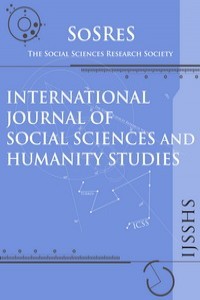THE RELATIONSHIP BETWEEN PSYCHOSOCIAL STRESSORS AND WORK ATTITUDES: THE MEDIATING EFFECTS OF PSYCHOLOGICAL STRAIN
THE RELATIONSHIP BETWEEN PSYCHOSOCIAL STRESSORS AND WORK ATTITUDES: THE MEDIATING EFFECTS OF PSYCHOLOGICAL STRAIN
Psychological strain psychosocial stressors, job satisfaction, affective commitment, turnover intention,
___
- Addae, H. M., Parboteeah, K. P., & Velinor, N. (2008). Role stressors and organizational commitment: public sector employment in St Lucia. International Journal of Manpower, 29(6), 567-582.
- Ahmad, Z. A., & Aafaqi, R. (2004). Organisational leadership in the Malaysian context. In D. Tjosvold & K. Leung (Eds.), Leading in High growth Asia: Managing relationship for teamwork and change (pp. 109-133). Hong Kong: World Scientific Publishing.
- Allen, N. J., & Meyer, J. P. (1990). The measurement and antecedents of affective, continuance and normative commitment to the organization. Journal of Occupational Psychology, 63(1), 1-18.
- Anton, C. (2009). The impact of role stress on workers' behaviour through job satisfaction and organizational commitment. International Journal of Psychology, 44(3), 187-194.
- Archibong, I. A., Bassey, A. O., & Effiom, D. O. (2010). Occupational stress sources among university academic staff. European Journal of Educational Studies, 2(3), 217-225.
- Ariffin, A. K., Ramli, N. F. L., Abdul, N. A., Husain, H., & Wahab, D. A. (2011). Faculty of Engineering and Built Environment Academicians’ Actual Hours of Workload. Procedia Social and Behavioral Sciences, 18, 5.
- Cooper, C. L., & Marshall, J. (1976). Occupational sources of stress: a review of the literature relating to coronary heart disease and mental ill health. Journal of Occupational Psychology, 49(1), 11-28.
- Cox, T., & Griffith, A. (2010). Work-related stress: a theoretical perspective. In S. Leka & J. Houdmont (Eds.), Occupational Health Psychology. United Kingdom: Wiley-Blackwell.
- Ganster, D. C. (2008). Measurement Challenges for Studying Work-related Stressors and Strains. Human Resource Management Review, 18, 12.
- Goldberg, D., & Williams, P. (1988). GHQ: A user's guide to the General Health Questionnaire Windsor: NFER/Nelson, Windsor.
- Hammer, T. H., Saksvik, P. O., Nytro, K., Torvatn, H., & Bayazit, M. (2004). Expanding the Psychosocial Work Environment: Workplace Norms and Work– Family Conflict as Correlates of Stress and Health. Journal of Occupational Health Psychology, 9(1), 83-97.
- Idris, M. K. (2011). Over Time Effects of Role Stress on Psychological Strain among Malaysian Public University Academics. International Journal of Business and Social Science, 2, 154-161.
- Karasek, R. A. (1979). Job demands, job decision latitude, and mental strain: Implication for job redesign. Administrative Science Quarterly, 24, 285-308.
- Kenny, D., & McIntyre, D. (2005). Constructions of occupational stress: nuisances, nuances or novelties. In Alexander-Stamatios, G. Antonio & C. L. Cooper (Eds.), Research Companion to Organizational Health Psychology. United Kingdom: Cornwall.
- O'Driscoll, M. P., & Brough, P. (2010). Work organizaton and health. In S. Leka & J. Houdmont (Eds.), Occupational health psychology (pp. 57-87). United Kingdom: Wiley-blackwell.
- Panatik, S. A. (2010). Impact of work design on psychological work reactions and job performance among technical workers: A longitudinal study in Malaysia. The University of Waikato, Hamilton, New Zealand.
- Pomaki, G., AnitaDeLongis, DanielaFrey, KathyShort, & TrishWoehrle. (2010). When the going gets tough: Direct, buffering and indirect effects of social support on turnover intention. Teaching and Teacher Education, 26, 7.
- Saari, L. M., & Judge, T. A. (2004). Employee attitudes and job satisfaction. Human Resource Management, 43(4), 395-407.
- Siegrist, J. (1996). Adverse health effects of high-effort/low-reward conditions. Journal of Occupational Health Psychology, 1(1), 27-41.
- Siegrist, J. (1999). Occupational health and public health in Germany. In P. M. L. Blanc, M. C. W. Peeters, A. Bussing & W. B. Schaufeli (Eds.), Organizational Psychology and Health Care (pp. 35-44). Munchen: Rainer Hampp Verlag.
- Siegrist, J. (2001). A theory of occupational stress. In J. Dunham (Ed.), Stress in the Workplace, Past, Present and Future. London: Whurr Publishers.
- Siegrist, J., Starke, D., Chandola, T., Godin, I., Marmot, M., Niedhammer, I., et al. (2004). The measurement of effort-reward imbalance at work: European comparisons. Social Science and Medicine, 58(8), 1483-1499.
- Spector, P. E. (2003). Industrial and Organisational Psychology: Research and Practice. Hoboken [NJ]: John Wiley.
- Verquer, M. L., Beehr, T. A., & Wagner, S. H. (2003). A meta-analysis of relations
- 1016/S0001-8791(02)00036-2]. Journal of Vocational Behavior, 63(3), 473- 489.
- Winefield, A. H., Gillespie, N., Stough, C., Dua, J., Hapuarachchi, J., & Boyd, C. (2003). Occupational Stress in Australian University Staff: Results From a National Survey. International Journal of Stress Management, 10(1), 13. [doi:
- Başlangıç: 2009
- Yayıncı: Sosyal Bilimler Araştırmaları Derneği
Melissa QUETULİO-NAVARRA, Anke NİEHOF, Wander Van Der VAART, Hilje Van Der HORST, Suliyanto Se MM
TWO STRATEGIC SUCCESS FACTORS FOR FIRM LEVEL COMPETITIVENESS: INNOVATION AND COOPERATION
Mehmet DENİZ, Şeyda Nur SEÇKİN, Mehmet CÜREOĞLU
DEPOSIT INSURANCE SYSTEM: AN EXPOSITION FOR THE ISLAMIC BANKS IN MALAYSIA
Sharifah Adlina Syed ABDULLAH, Rubi AHMAD
THE LEGAL CHARACTERS OF THE SALES CONTRACT
Sorin FİLDAN, Narcisa Mihaela STOİCU
DOES OVERVALUED TURKISH LIRA AFFECT TURKEY’S FOREIGN TRADE COMPETITIVENESS?
Eren ERDOGAN, Osman Nuri ARAS, Mustafa OZTURK
LEADERSHIP AND PROFESSIONALISM AS FUTURE CHALLENGE IN PUBLIC SECTOR UNIVERSITY MANAGEMENT
Dita STEFENHAGENA, Voldemars BARİSS
DETERMINANTS OF DEBT CRISIS IN EU AND THE RECOVERY EFFORTS
Mustafa ÖZTÜRK, Osman Nuri ARAS, Filiz Salih KADI
STOCKHOLDING AND FINANCIAL LITERACY IN THE FRENCH POPULATION
